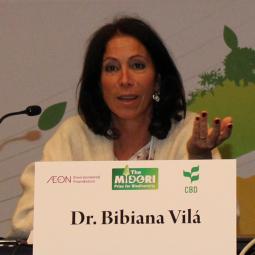Member Profile

Membership type: full
Bibiana L. Vilá
Country of origin: Argentina Currently in: Argentina, Lujan, Buenos Aires General field of specialization: Biological Systems and Organisms-
Degrees
1990 Doctorate Biological Systems and Organisms1994 Doctorate Biological Systems and Organisms -
Current Research Activities
Biological Systems and Organisms
Ecological research on Andean altiplano. Environmental education and ecology in the Puna area of Argentina. Behavioural ecology of South American camelids and other mammals. Sustainable management of wild camelids (vicunas). Environmental education and ecology in the Puna area of Argentina. Behavioural ecology of vacunas.
Publications resulting from Research:
5) Vilá B.L. y Roig V.G. 1992. Diurnal movements, family groups and alertness of vicuña (Vicugna vicugna)
during the late dry season in the Laguna Blanca Reserve (Catamarca-Argentina). Small Ruminant Research, 7: 289-297.
ISSN 0921-4488. Elsevier. Amsterdan. Holanda.
6) Vilá B.L. 1992. Mother-offspring relationship in the vicuña, Vicugna vicugna (Mammalia: Camelidae). Ethology, 92: 293-300.
ISSN 1439-8310. IF (ISI) 1.902 Wiley-Blackwell. USA.
7) Vilá B.L. y Cassini M.H. 1993. Summer and autumn activity patterns of vicuña. Studies on Neotropical Fauna
& Environment, 28: 251-258.
ISSN 0165-0521. ISSN 0165-0521 (1744-5140 on line). Taylor & Frances. Londres. UK.
8) Vilá B.L. 1994. Use of dung piles by neighbouring vicuñas. Inter. J. of Mammalian Biology (Z. fur
Sargetierkunde), 59: 126-128.
ISSN 0049-3468 (on line 1616-5047). IF 1.902. Elsevier. Amsterdam. Holanda.
9) Vilá B.L. 1994. Clasificación de las duplas madre-cría de vicuñas. Ecología Austral, 4: 59-63.
ISSN 1667-7838. ASAE. Buenos Aires. Argentina.
10) Vilá B.L. 1994. Some aspects of playing behaviour in the vicuña. Small Ruminant Research, 14: 245- 248.
ISSN 0921-4488. Elsevier. Amsterdan. Holanda.
11) Vilá B.L. y Cassini M.H. 1994. Time allocation during the reproductive season in vicuñas. Ethology, 97:
226-235.
ISSN 1439-8310. IF (ISI) 1.902 Wiley-Blackwell. USA.
12) Vilá B.L. 1995. Spacing patterns within groups in vicuñas in relation to sex and behaviour. Studies on
Neotropical Fauna & Environment, 30 (1): 45-51.
ISSN 0165-0521 (1744-5140 on line). Taylor & Frances. Londres. UK.
13) Vilá, B.L. 1999. La importancia de la etología en la conservación y manejo de las vicuñas. Número
especial de la revista Etología (España), 7, 63-68.
ISSN 1130-3204. Asoc. Española Etología. Barcelona. España.
14) Renaudeau d´Arc N., Cassini M., Vilá B. 2000. Habitat use of vicuñas in Laguna Blanca Reserve
(Catamarca, Argentina). Journal of Arid Environments, 46: 107-115.
ISSN 0140-1963. Elsevier. Amsterdam. Holanda.
15) Vilá, B.L. 2002. La silvestría de las vicuñas, una característica esencial para su conservación y manejo.
Ecología Austral, (12), 1, 79-82.
ISSN 1667-7838. ASAE. Buenos Aires. Argentina.
16) Yacobaccio H. y Vilá B.L. 2002. Condiciones, mecanismos y consecuencias de la domesticación de
camélidos. Estudios Sociales del NOA, 5 (5), 4-27.
ISSN 0329-8256. Instituto Interdisciplinario Tilcara. UBA.
17) Lichteinstein G. y Vilá B.L. 2003. Vicuna use by Andean communities: an overview. Mountain Research &
Development, 23 (2): 198-202.
ISSN 1994-7151. Int. Mountain Soc. IMS. Berna. Suiza.
23
Vilá/CV/ 23
18) Arzamendia Y. Cassini M. y Vilá B. 2006. Habitat use by vicuñas, Vicugna vicugna, in Laguna Pozuelos Reserve (Jujuy, Argentina). Oryx, 40 (2), 198-203.
ISSN 0030-6093. Cambridge Univ. Press. Cambridge. UK IF (ISI): 1.381
19) Borgnia, M., Maggi A., Arriaga M., Aued B. Vilá B., y Cassini M. 2006. Caracterización de la vegetación en la Reserva de Biósfera Laguna Blanca (Catamarca, Argentina). Ecología Austral, 16, 29-45
ISSN 1667-7838. ASAE. Buenos Aires. Argentina.
20) Borgnia M., Vilá B. y Cassini M. 2008. Interaction between wild camelids and livestock in an Andean semidesert. Journal of Arid Environment, 72. 2150-2158
ISSN 0140-1963. Elsevier. Amsterdam. Holanda. IF (ISI) 1.589.
21) Borgnia M. Vilá BL. y Cassini MH. 2010. Foraging ecology of vicuñas (Vicugna vicugna) in dry argentinean puna. Small Ruminant Research. 88 (1), 44-53.
ISSN 0921-4488. Elsevier. Amsterdan Holanda. IF (ISI) 1.198
22) Marcoppido, G., Parreño, V. y Vilá, B. 2010. First serological survey of antibodies against pathogenic viruses in a wild vicuña (Vicugna vicugna) population in the Argentinean Andean altiplano. Journal of Wildlife Diseases. 46 (2), 608-614.
ISSN 0090-3558. Wildlife Disease Association. Allen Press. USA. IF (ISI): 1.330
23) Vilá B., Wawrzyk A. y Arzamendia Y. 2010. El manejo de vicuñas silvestres (Vicugna vicugna) en Jujuy (Argentina): Un análisis de la experiencia del proyecto MACS, en Cieneguillas. Revista Latinoamericana de Conservación. 1 (1) 38-52.
ISSN 2027-3851. Bogotá. Colombia.
24) Arzamendia Y., Bonacic C. y Vilá B. 2010. Behavioral and physiological consequences of capture for shearing vicuñas in Argentina. Applied Animal Behaviour Science 125, 163-170.
ISSN 0168-1591. Elsevier. Amsterdam Holanda.
Official Journal of the International Society for Applied Ethology (ISAE) IF (ISI): 1.823
25) Arzamendia Y. y Vilá B. 2012. Effects of Capture, Shearing and Release on the Ecology and Behavior of Wild Vicuña. Journal of Wildlife Management, 76(1): 54-64..
ISSN: 0022-541X.
Official Journal of the Wildlife Society (JWS). Columbia. USA. IF (ISI): 1.361.
2009 ISI Journal Citation Reports® Rankings: 43/127 – Zoology
26) Rojo V., Arzamendia Y. y Vilá B. 2012. Uso del hábitat por vicuñas (Vicugna vicugna) en un sistema agropastoril en Suripujio, Jujuy. Mastozoología Neotropical. 19 (1):127-138.
ISSN 0327-9383 (printed ) ISSN 1666-0536 (online).
Revista editada por Soc. Arg. para el estudio de los Mamíferos. Indexada en: Biological Abstract, Wildlife Review, Zoological Record.
27) Arzamendia Y, Neder, L E, Marcoppido G, Ortiz F, Arce de Hamity M, Lamas H y Vilá B.2012. Effect of the prevalence of ectoparasites in the behavioral patterns of wild vicuñas (Vicugna vicugna). Journal of Camelid Science, 5: 105-117
International Society of Camelid Research and Development (ISOCARD) ISSN 1999-8732
28) Wawrzyk A. y Vilá B. 2013. Dinámica del pastoreo en dos comunidades (Lagunillas del Farallón y Suripujio) de la puna de Jujuy, Argentina. Chungara, 45 (2). 349-362.
Editada por Universidad de Tarapaca. Chile. ISSN 0717-7356 Indexada en SciELO.
29) Yacobaccio H. y Vilá B. 2013. La domesticación de los camélidos andinos como proceso de interacción humana y animal. Intersecciones en Antropología, 14. 227-238.
ISSN 1666-2105.
Indexada en: LATINDEX (Folio No. 15044); CAICYT- CONICET; DOAJ (Directory of Open Access Journals); Social Science Citation Index; Arts & Humanities Citation Index; Zoological Record, Redalyc.
30) Wawrzyk A. y Vilá B. 2013. Analysis of the perception of the wild vicuña by children and teeneagers in the Andean altiplano of Argentina. Journal of Ecological Anthropology, 16 (1), 27-42.
Indexado en Anthropological Literature, Abstracts in Anthropology, Sociological Abstracts, Social Services Abstracts, Worldwide Political Science Abstracts, and Linguistics and Language Behavior Abstracts.
24
Vilá/CV/ 23
ISSN 1528-6509.
31) Marcoppido G. y Vilá B.L. 2013. Manejo de Llamas extra-andinas. Aspectos para su bienestar en un
contexto no originario. RAPA. Revista Argentina de Producción Animal Vol 33 (2): 139-154. ISSN 2314- 324X (on
line) y ISSN 0326-0550 (impreso).
32) Vilá B.L.2014. Una aproximación a la etnozoología de los camélidos andinos. Etnoecológica, 10 (5), 1-16.
Mexico. CONACYT.
Indexada en Latindex.
33) Arzamendia, Y. and B. Vilá. 2014. Vicugna habitat use and interactions with domestic ungulates in Jujuy,
Northwest Argentina. Mammalia. 79: 267-278.isbn 1864-1547
34) Arzamendia Y., Baldo J., Rojo V., Samec C. y Vilá B. 2014. Manejo de vicuñas silvestres en Santa Catalina,
Jujuy: Investigadores y pobladores en búsqueda de la sustentabilidad y el buen vivir. Nº2 (1), 8-23.
Cuadernos del Instituto Nacional de Antropología y Pensamiento Latinoamericano-Series Especiales. “Conductas
Culturales hacia los Animales en América del Sur: pasado y presente”. ISSN 2362- 1958. CAICYT.
35) Vilá B.L. 2015. Camélidos en Santa Catalina (Jujuy, Argentina): Manejo de vicuñas y caravanas de
llamas. Etnobiología 13 (3), 19-37. Mexico. CONACyT.
Ed por: Soc Mexicana de Etnobiología. ISSN 1665-2703
Indexada en EBSCO, LATINDEX, PERIÓDICA. Publicación electrónica de libre acceso. REDIB (Red
Iberoamericana de Innovación y Conocimiento Científico), DIALNET, Google scholar. ISSN: 1665-2703.
36) Vilá B.L. 2015. Los camélidos como parte del patrimonio biocultural de los Andes. Revista Rúbricas, 6 (9):
40-51 .Universidad Iberoamericana de Puebla. México. Derechos autor 04-2011- 02410194000-102.
37) Yacobaccio H. y Vilá B. 2016. A model for llama Lama glama domestication. Anthropozoologica, 51 (1), 5-
13. Museo de Historia Natural. París. Print ISSN: 0761-3032. Online ISSN: 2107-0881. IP: 0.136. ISI Journal
Citation Reports® Ranking: 75/83 - Anthropology
38) Marcoppido G., Schapiro J., Morici G., Arzamendia Y. y Vilá b. 2016. First coproparasitological evaluation of
gastrointestinal parasites in a wild vicuña (Vicugna vicugna) population in the Argentinean Andean
Altiplano. Journal of Camelid Science, (9) 23-34. International Society of Camelid Research and Development.
Emiratos Arabes Unidos. Abu Dhabi.
39) Vilá B. y Arzamendia Y. 2016. Construcción de un calendario ambiental participativo en Santa Catalina,
Jujuy, Argentina. Revista Etnobiologia. Vol 14, Num. 3. Diciembre 2016. pp: 71-83. Mexico. CONACyT. Ed por:
Soc Mexicana de Etnobiología. ISSN 1665-2703. Indexada en EBSCO, LATINDEX, PERIÓDICA. Publicación
electrónica de libre acceso. REDIB (Red Iberoamericana de Innovación y Conocimiento Científico), DIALNET,
Google scholar
40) Rojo V., Arzamendia Y., Perez C., Baldo J., Vilà B. 2017. Estimation of Andean shrubs and tussocks
biomass by double sampling methods. Rangeland Ecology and Management, 70, 718-722.
http://dx.doi.org/10.1016/j.rama.2017.06.003
41) Marcoppido G., Arzamendia Y. y Vilá B. 2017. Physiological and behavioral indices of short-term
stress in wild vicuñas (Vicugna vicugna) in Jujuy Province, Argentina. Journal of Applied Animal Welfare Science,
https://doi.org/10.1080/10888705.2017.1403324
42) Arzamendia Y. Carbajo A. y Vilá B. 2018. Social group dynamics and composition of managed wild vicuñas
(Vicugna vicugna vicugna) in Jujuy, Argentina Journal of Ethology, 36(2) 125-134 DOI 10.1007/s10164-018-0542-3
43) Vilá B. 2018. In the brink of extinction: Llama caravans arriving to the Santa Catalina fair, Jujuy. Journal
of Ethnobiology, en prensa.
Otras publicaciones sobre camélidos (divulgación, técnicas, etc):
1) Vilá.B.L. 1989. Paisaje con vicuñas. CIENCIAHOY, 1 (4): 46-55. (Divulgación)
ISSN 0327-1218. ACH. Buenso Aires, Argentina.
2) Vilá B.L. 1994. Revisión del libro:" La evolución del cuidado parental" de T.H. Clutton Brock.
Mastozoología Neotropical. 2: 171-172. (basado en paper 5).
25
Vilá/CV/ 23
3) Vilá B.L. & Ruscitti A. 1994. La utilización sustentable de los Camélidos Silvestres. Boletín de
Camélidos Argentinos N 6.Unión Europea- Rep. Argentina. 6 pp.
4) Vilá B.L. 1995. La Brava Reserva de Laguna Brava. CIENCIAHOY, 5 (21): 25-32.
ISSN 0327-1218. ACH. Buenso Aires, Argentina.
5) Vilá B.L. 2000. Los camélidos y sus pastores. pag 30-41. Revista Unlu-Ciencia, 2 (1).
6) Vilá B.L. 2001. Las vicuñas en Cieneguillas y Vilama: Cuando los pobladores llaman a los
científicos. CIENCIAHOY, 11, 65, 20-26.
ISSN 0327-1218. ACH. Buenso Aires, Argentina.
7) 2003. PLAN DE MANEJO DE LAS VICUÑAS EN CIENEGUILLAS.
8) Vilá B.L., Bonacic C., Arzamendia Y., Wawrzyk A. y Lamas H. 2004. Captura y esquila de vicuñas en
Cieneguillas. CIENCIAHOY, 14 (80) 44-55.
ISSN 0327-1218. ACH. Buenso Aires, Argentina.
9) 2013. Vilá B. Etnoecología para la conservación y el manejo sustentable de vicuñas silvestres.
Ciencia con voz propia. CONICET. 30 abril. 2013. www.conicet.gov.ar
10) Baldo J., Arzamendia Y., Marcoppido G., Rojo V., Samec C., Yacobaccio H. y Vilá B. 2015.
Investigadores y pobladores andinos con un proyecto en común: Sustentabilidad y Buen Vivir.
Captura y esquila de vicuñas silvestres en Santa Catalina, Jujuy, Argentina. GECS-IUCN news, Nro 5.
Pag 4-11.
11) Vilà B.L. 2016. ¿Camellos en Argentina? CIENCIAHOY de los Chicos, 1 (2): 7-11. ISSN 2451-6317
12) Vilà B.L. 2016. Sobre gustos y costumbres…hablemos de etnobiologia., 2 (4): 4-5. . ISSN 2451-6317
13) Vilà B.L. 2017. Biodiversidad, el éxito de la vida. CIENCIAHOY de los Chicos. En prensa.
Current profession
Current professional activities type:ResearchTeachingOtherI am member of MEP Multidisciplinary Expert Panel in IPBES The Intergovernmental Science-Policy Platform on Biodiversity and Ecosystem Services (IPBES) is the intergovernmental body which assesses the state of biodiversity and of the ecosystem services it provides to society, in response to requests from decision makers.
Workshop and Conference Attended
more than 100, see cv attachedAffiliations
CONICET: National Research CouncilPresentation given
more than 100, see Cv attachedEvent: -
Other Awards
Sep 2014Midori Prize for Biodiversity AEON-CBD-UNThe MIDORI Prize is a biennial international prize organized by the AEON Environmental Foundation and the Secretariat of the Convention on Biological Diversity (CBD) to honor individuals who have made outstanding contributions to the conservation and sustainable use of biodiversity at global, regional or local levels. Dr. Bibiana Vilá (Argentina) Director, Vicuñas, Camelids and Environment (VICAM) Principal Researcher, National Research Council (CONICET), Argentina Dr. Bibiana Vilá’s (b. 1961) work focuses on the conservation of wild vicuñas (*1) in the Andean altiplano. Dr. Vilá has led the implementation of conservation measures integrating both traditional knowledge of indigenous communities and modern science including ecology, ethology and animal welfare. She has also promoted support to local communities and environmental education. This has been achieved through the sustainable use of economically high-value vicuna fiber realizing both the conservation of wild animals and the stable development of regional communities. Dr. Vilá’s achievements related to the conservation and sustainable use of vicuñas can be seen as a modern model for conservation, with very significant impacts. In the Andean altiplano, vicuñas are a wild species of enormous ecological, economic and socio-cultural importance, and highly prized for the utility of their fine fleece. However, vicuñas were slaughtered in large numbers for centuries and their population massively decreased. In order to attain a recovery of numbers and promote their sustainable use, Dr. Vilá has led Vicuñas, Camelids and Environment (VICAM*2), a research group, and recovered, in collaboration with local Andean communities, an ancient prehispanic wildlife capture technique, the “Chaku,” that enables shearing fiber from live vicuñas by surrounding them. The group has developed approaches which will permit the regular capture and shearing and release of wild vicuñas. The approaches generate income for economically deprived indigenous communities and give the communities the incentives of conservation of ecosystems and species. The group’s efforts aim at long-term vicuña conservation and stabilization and the improvement of livelihoods of indigenous communities. This is achieved through blending local indigenous knowledge and a modern scientific approach, encouraging the independence of local indigenous communities, and environmental education. Her activities are a good example of realizing the concept of “living in harmony with nature.” Dr. Vilá’s contributions as a leader who has realized both the conservation of wildlife and stable development of local communities are highly valued. (*1) Vicuñas Vicuñas are wild South American camelids. Vicuñas are listed under Appendix II of the Convention on International Trade on Endangered Species (CITES) (some populations in Argentina and other countries, are still vulnerable and listed in Appendix I). Fine vicuña fiber is treated as a luxury item. (Note: Some populations are listed in ap I and others are listed in ap II, depending on the conservation situation, it is not a rule for the entire species) (*2) Vicuñas, Camelids and Environment (VICAM) VICAM, a research group on vicuñas, camelids and the environment, has approached conservation aspects from biological and social science perspectives, including environmental education. Twelve researchers promote the scientifically-based sustainable use of biodiversity while respecting the traditional perceptions of indigenous communities.






